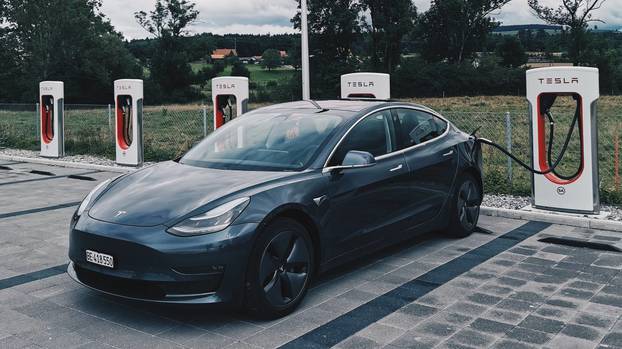Electromobility is seen as providing a way out of the climate crisis and is framed as being able to greenify the transport sector, which contributes prominently to CO2 emissions. However, if the transition to electromobility continues to be organized in the way currently proposed by the federal government, the Greens, many mobility transition groups, and environmental associations, CO2 emissions are likely to rise and existing crises to worsen. This is due to the following reasons:
Winfried Wolf is editor-in-chief of LunaPark21—Zeitschrift zur Kritik der globalen Ökonomie. Together with Bernhard Knierim, he is the co-author of the recently-released Abgefahren. Warum wir eine neue Bahnpolitik brauchen. This article originally appeared in LuXemburg, and was translated by Hunter Bolin and Ryan Eyers for Gegensatz Translation Collective.
- Environmental Heavyweights
The process of manufacturing an electric car emits between three and eight tonnes more CO2 than the building of a petrol or diesel vehicle of the same size, because the production of the batteries used in electric cars is extremely energy intensive. When the entire life cycle of a car, including its production and disposal, is taken into account, the German Environment Agency assumes that an electric car will result in a maximum 30 percent reduction in CO2 emissions compared to cars with internal combustion engines. VW claims “50 percent, assuming you drive on green electricity”. But 100-percent green electricity does not exist. And there is still no solution to the issue of lithium-ion batteries’ low recyclability. - Clean Energy Does Not Exist (Yet)
A significant portion of electricity will continue to be generated from fossil fuels for the foreseeable future: in Germany, this figure currently sits at.over 35 percent, rises to 65 percent in China, and climbs further to 70 percent worldwide. Increasingly, CO2 is being emitted where the power plants themselves are located, instead of just in the cities. Millions of electric cars will necessitate an additional expansion of power generation capacities, which will revive the demand for coal as well as nuclear power. - Electric Cars as Second Cars
The rebound effect describes how improved efficiency can lead to an overall increase in the consumption of a particular product and in consumption overall. Rather than replacing conventional cars, electric cars are instead being purchased to supplement people’s primary vehicles. More than half of all electric cars are a consumer’s second or even third cars, partly because they can only travel a relatively short distance on a single charge and on top of that take a long time to re-charge (additionally, their hefty price tag also means that they are only available to the wealthy). - Cars Instead of Transportation Systems
Electric cars appear to offer an environmentally conscious alternative to the combustion engine, which provides consumers with an incentive to switch to this supposedly more environmentally friendly form of car-based mobility. But in many cases, people who drive electric cars would have previously travelled by bicycle and public transport—another example of the rebound effect that reinforces the negative impact of car traffic and weakens local transport systems. - More Combustion, Not Less
Adherents always point to the ever-increasing number of electric cars being registered. However, they rarely check whether the absolute number of conventional cars is decreasing as a result. In 2019, 63,281 new electric cars were registered in Germany. They now make up 1.8 percent of registered cars, an almost twofold increase in number. At the same time, however, 3.6 million conventional cars were newly registered. The total number of cars once again saw a massive increase of more than 1.2 million. The combined CO2 emissions produced by cars with internal combustion engines and electric cars combined thus actually rose significantly. - A New Dependence on Scarce Raw Materials
Even with electric mobility, the dependence on the finite resource that is oil will remain‑as previously noted, as the number of combustion engines on the road continues to rise each year. With the electric car, this will be complemented with a dependence on finite raw materials such as copper, lithium, cobalt, and rare earth metals. Alongside the long-running global conflicts surrounding oil, we could also see military incursions to secure cobalt supplies and wars over lithium. - Traffic Remains the Problem
Even if all 950 million cars on the planet were electric cars, there would still be 1.2 million deaths and 100 million serious injuries on the road per year. Electric cars pose an enormous risk in terms of causing accidents, especially at lower speeds, since they remain almost silent when travelling under 40 km/h. Disability advocacy groups have repeatedly pointed out these specific accident risks. Even if electric cars replaced conventional cars in all major cities, the amount of space consumed as a result of this avalanche of cars would be at least five times greater than if that same space were used for walking, cycling, or public transport.
The Electric Car as a Crisis Accelerator
All in all, the electric car generates a net positive in CO2 emissions and contributes to the expansion of the global car fleet. It perpetuates the fatal trend initiated by the internal combustion engine in which the reasonably luxurious mobility enjoyed by many in the OECD is reliant on overexploitation and environmental destruction in the “third world”. What’s more, this shift does nothing to alleviate the problems created by a system of transportation that specifically tailored to suit the needs of the car.
